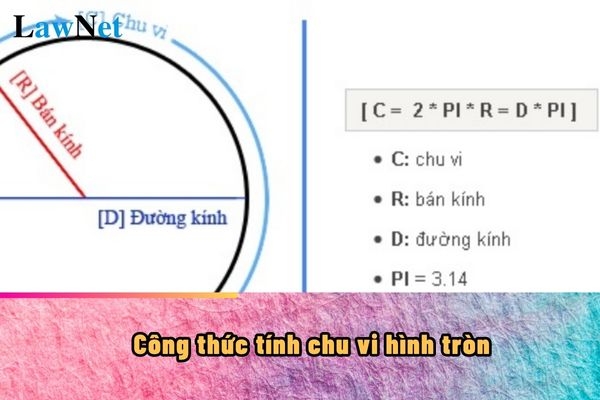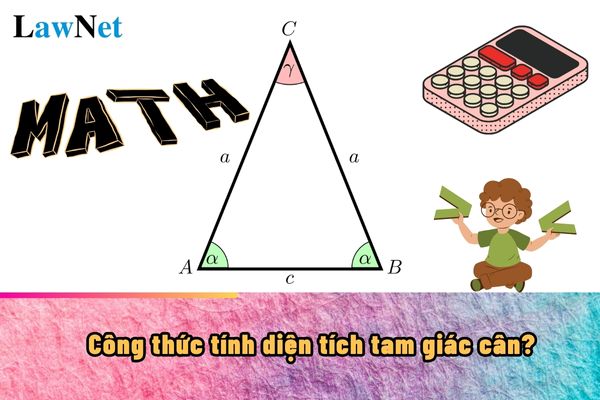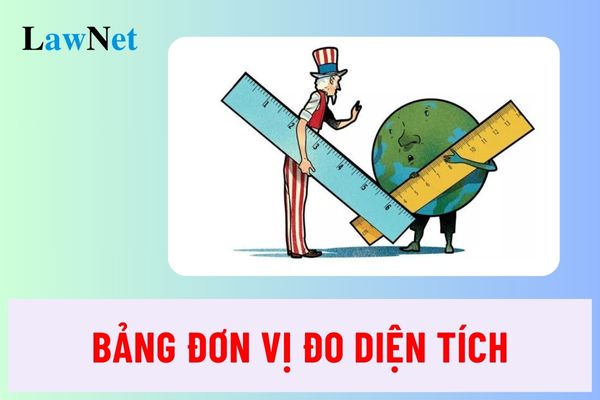What is the formula for calculating the circumference of a circle?
What is the formula for calculating the circumference of a circle?
The formula to calculate the circumference of a circle is a mathematical formula used to determine the circumference of a circle.
The formula to calculate the circumference of a circle is as follows:
|
Formula to Calculate the Circumference of a Circle There are two ways to calculate the circumference of a circle: Method 1: Based on the Diameter *In which: Method 2: Based on the Radius *In which: |
*Note: The information is for reference only./.

What is the formula for calculating the circumference of a circle? (Image from the Internet)
Is the formula for calculating the circumference of a circle taught in grade 5 in Vietnam?
Based on Section III, Appendix of the Mathematics Primary Education Program issued together with Circular 32/2018/TT-BGDDT, the formula to calculate the circumference of a circle is taught in grade 5 under the program.
The measurement knowledge section that students will learn includes three parts:
[1] Concepts of quantity and units of measurement, which will include learning:
- Recognizing units of area measurement: km2 (square kilometer), ha (hectare).
- Recognizing "volume" through specific concepts.
- Recognizing some common volume units: cm3 (cubic centimeter), dm3 (cubic decimeter), m3 (cubic meter).
- Recognizing the speed of uniform motion; names and symbols of some speed units: km/h (kilometer per hour), m/s (meter per second).
[2] Practicing measurement, which will include learning:
Using some common tools to practice weighing, measuring, counting, keeping time, shopping with learned quantity units and currency.
[3] Calculations and estimations with measurement units, which will include learning:
- Performing conversions and calculations with volume units (cm3, dm3, m3) and time units.
- Calculating the area of a triangle, trapezoid.
- Calculating the circumference and area of a circle.
- Calculating the surrounding area, total surface area, and volume of rectangular boxes and cubes.
- Performing volume estimation in some simple cases (e.g., the volume of a chalk box, etc.).
- Solving real-world problems related to measuring volume, capacity, time.
- Solving some problems related to uniform motion (finding speed, distance, time).
Thus, it is evident that the formula to calculate the circumference of a circle is taught in the grade 5 mathematics program.
What are principles of constructing the Mathematics curriculum in Vietnam?
Based on Section II, Appendix of the Mathematics Primary Education Program issued together with Circular 32/2018/TT-BGDDT, when constructing the Mathematics curriculum, the following principles must be ensured:
The Mathematics curriculum adheres to the basic regulations outlined in the overall program; inherits and promotes the advantages of the current program and previous programs, selectively incorporates the curriculum-building experiences of advanced countries, and approaches educational science achievements, taking into account Vietnam's economic and social conditions.
Furthermore, the Mathematics curriculum emphasizes the following principles:
Principle 1. Ensuring simplicity, practicality, and modernity
The Mathematics curriculum ensures simplicity, practicality, and modernity by reflecting the contents that must be addressed in general education, meeting the need to understand the world as well as the interests and preferences of learners, in line with the current global approach.
The curriculum embodies the spirit of "mathematics for everyone", allowing everyone to learn Mathematics in a way that suits their preferences and abilities.
The Mathematics curriculum focuses on application, closely connecting with real-life scenarios and other subjects, particularly those related to STEM education, aligning with modern economic, scientific, societal developments, and global pressing issues (such as climate change, sustainable development, financial education, etc.).
This is also reflected through practical and experiential activities in mathematics education in various forms such as research projects, especially those on the application of mathematics in real life;
Organizing math competitions, math clubs, forums, seminars, creating opportunities for students to creatively apply their knowledge, skills, and experiences in real life.
Principle 2. Ensuring consistency and continuous development
The Mathematics curriculum ensures consistency and continuous development (from Grade 1 to Grade 12), comprising two tightly interlinked strands: one describing the development of core content knowledge strands and the other describing the development of students' capabilities and qualities.
Additionally, the Mathematics curriculum ensures continuity with the preschool education program and lays the foundation for vocational education and higher education.
Principle 3. Ensuring integration and differentiation
The Mathematics curriculum integrates internal disciplines around three knowledge strands: Numbers, Algebra and some elements of analysis; Geometry and Measurement; Statistics and Probability; integrates interdisciplinary topics through related contents or mathematics knowledge used in other subjects like Physics, Chemistry, Biology, Geography, Informatics, Technology, History, Arts, etc.;
It integrates internal and interdisciplinary practices through practical and experiential activities in mathematics education.
Simultaneously, the Mathematics curriculum ensures differentiation. For all educational levels, the Mathematics curriculum upholds the spirit of personalized learning based on the assurance that the majority of students (across all regions of the country) meet the required program standards; it also pays attention to specific groups (gifted students, students with disabilities, students in difficult circumstances, etc.).
For the high school level, the Mathematics curriculum includes in-depth study topics and materials to help students enhance their knowledge, practical skills, and problem-solving abilities related to real-life scenarios.
Principle 4. Ensuring openness
The Mathematics curriculum ensures clear orientation and core, mandatory mathematics education content for students nationwide, while granting autonomy and responsibility to localities and schools in selecting, supplementing some mathematics education content, and implementing education plans suitable for local conditions and the specific conditions of the educational institution.
The Mathematics curriculum only specifies general principles, orientations about the required achievements regarding the qualities and competencies of students, educational content, teaching methods, and educational outcome assessments, without being overly detailed, allowing textbook authors and teachers to exercise active, creative implementation.
The curriculum ensures stability and the ability to develop during its implementation to keep up with scientific-technological advancements and real-life requirements.
>>> See more Preparing lessons for Grade 10 Math according to Canh Dieu textbook (Volume 1) in Vietnam
>>> See more Guidelines for preparing the lesson Thanh âm for Grade 5 in Vietnam
>>> See more Guidelines for preparing lessons on nouns, verbs, and adjectives for Grade 5 Vietnamese subject in Vietnam
>>> See more Guidelines for practicing words and sentences (pronouns) for Grade 5 Vietnamese subject in Vietnam
>>> See more Descriptive essay about the teacher for Grade 5 students in Vietnam in academic year 2024-2025
>>> >>> Download the Mathematics Education Program issued together with Circular 32/2018/TT-BGDDT.







- Sample explanation essay on flooding for grade 8 students in Vietnam
- Are lower secondary school teachers in Vietnam required to have a master's degree?
- Guidelines on preparing the lesson "Chiều xuân" for grade 11 students in Vietnam
- Ho Chi Minh City propagates, mobilizes, and raises donations to support northern provinces affected by Typhoon No. 3
- Guidelines on preparing the lesson "Ngôi sao sân cỏ" for grade 5 students in Vietnam
- Planning of the Network of Higher Education and Teacher Training Institutions for the Period of 2021-2030
- Poem about Sine, Cosine, Tangent (trigonometric ratios in right triangles) for grade 9 students in Vietnam
- Guidelines on writing a disciplinary report for lower secondary school students in Vietnam
- What is the Application form for extra classes at school in 2024 in Vietnam?
- When is the Mid-Autumn Festival in 2024? How many days until the Mid-Autumn Festival in 2024?

